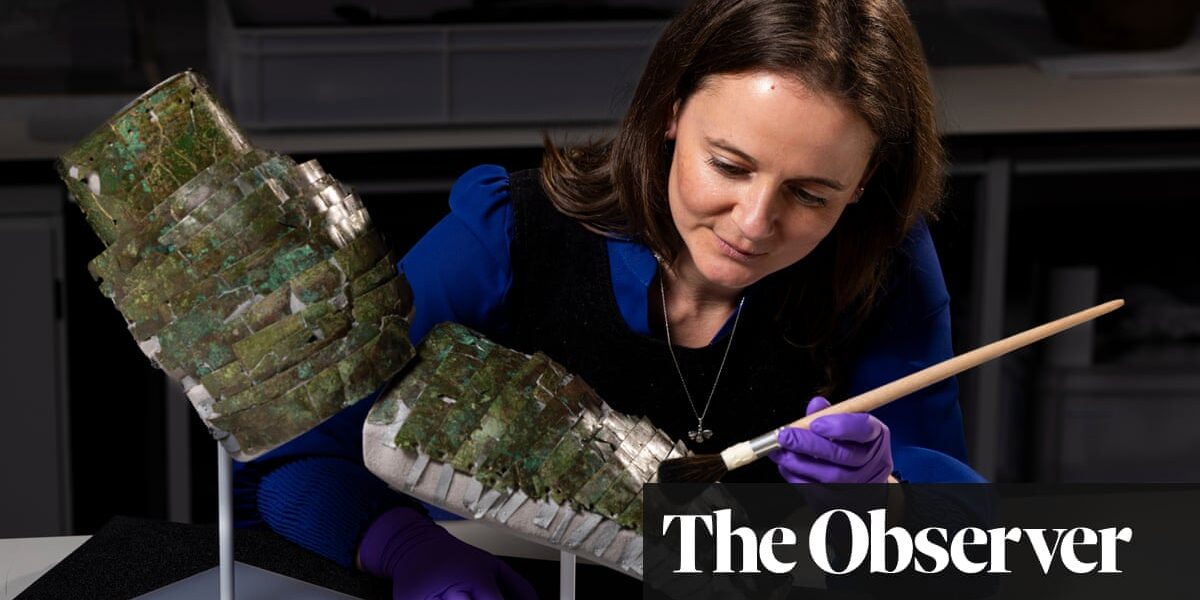An incredible reconstruction has brought a shattered Roman arm guard, dating back 1,800 years, back to life using 100 fragments.

A magnificent brass arm guard, dating back to 1,800 years ago, has been reconstructed using over 100 pieces discovered at Trimontium, a Roman fort in Scotland.
National Museums Scotland (NMS) in Edinburgh has successfully assembled the exceptional jigsaw puzzle and will be loaning the arm-guard to the upcoming exhibition on the Roman army at the British Museum.
Made in the second century – with brass strips overlapping like an armadillo’s scales – it is one of only three known from the whole Roman Empire, and the most intact.
Although many arm-guards were crafted from iron for practicality, brass would have appeared as a golden adornment on a soldier’s arm, signifying their rank in battle.
Fraser Hunter, the primary curator for prehistoric and Roman archaeology at the National Museum of Scotland, expressed his astonishment, stating, “It’s truly incredible. This individual was clearly well-protected and held in high regard. The golden armor would have shone and looked incredibly stunning when worn.”
In 1906, James Curle, a lawyer and antiquary, made a discovery at the Trimontium fort in Newstead, located near Melrose in the Scottish Borders. He initially believed it to be a guard for the chest and shoulders, but could not find any similar items. In the 1990s, it was determined to be an arm-guard, but it has only recently been fully reconstructed.
Hunter noted that while they were working on the fragments, he came to the realization that they had the entire piece. He also mentioned that the British Museum exhibition was what prompted them to have the necessary time and resources to bring all the pieces together.
This is most likely a critical piece of a legionary’s kit, he believes: “We know that there [were] legionaries in the garrison at the time. Because of the glamour of it – and brass was an expensive metal then – it’s probably a high-ranking centurion.”
He stated that the adjusted layout would have redirected any attack, and the padding underneath absorbed most of the force, ensuring complete protection for your right arm.
In approximately 180 AD, the Romans experienced turmoil and instability in Scotland, as mentioned in a literary source describing barbarians killing a general and his soldiers.
Although the fragments have been in NMS’s possession for over 100 years, one piece was exhibited for 25 years and another portion was loaned to the Trimontium Museum. Other fragments from it were kept in storage.
Bethan Bryan, the conservator of artefacts for the NMS, stated that completing the jigsaw puzzle was both a difficult task and a passion project.
Pass over advertising of newsletters.
after newsletter promotion
It required approximately three weeks to finish and at times appeared unattainable due to the minuscule size of some fragments. Bryan stated, “Examining the same things for three weeks can strain your eyes and mind.” However, every single piece was successfully placed.
The metal is well-preserved, and the corrosion patterns reveal where the leather and padding were once attached. Some remnants of the original leather remain intact.
The arm-guard was likely forgotten during the Romans’ departure from Trimontium. Prior to that, an estimated 2,000 individuals resided in the area and its surrounding settlement.
The protective arm shield was stored at the main base of the most recent fort on the site. Hunter clarified, “This was the location where the leader would update their officers. However, it also appears to have been used as a repair shop for military gear. When the structure was deserted, any excess equipment was simply discarded.”
Source: theguardian.com


